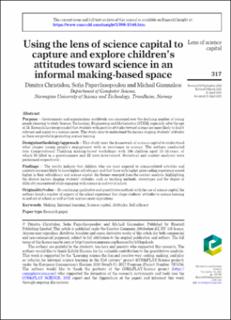| dc.contributor.author | Christidou, Dimitra | |
| dc.contributor.author | Papavlasopoulou, Sofia | |
| dc.contributor.author | Giannakos, Michail | |
| dc.date.accessioned | 2022-02-25T07:24:18Z | |
| dc.date.available | 2022-02-25T07:24:18Z | |
| dc.date.created | 2021-08-15T23:01:41Z | |
| dc.date.issued | 2021 | |
| dc.identifier.citation | Information and Learning Science (ILS). 2021, 12 (5/6), 317-340. | en_US |
| dc.identifier.issn | 2398-5348 | |
| dc.identifier.uri | https://hdl.handle.net/11250/2981341 | |
| dc.description.abstract | Purpose
Governments and organizations worldwide are concerned over the declining number of young people choosing to study Science, Technology, Engineering and Mathematics (STEM), especially after the age of 16. Research has foregrounded that students with positive attitudes toward science are more likely to find it relevant and aspire to a science career. This study aims to understand the factors shaping students’ attitudes as these are pivotal in promoting science learning.
Design/methodology/approach
This study uses the framework of science capital to understand what shapes young people’s engagement with or resistance to science. The authors conducted four Computational Thinking making-based workshops with 106 children aged 15–16 years, of which 58 filled in a questionnaire and 22 were interviewed. Statistical and content analyses were performed respectively.
Findings
The results indicate that children who are more exposed to science-related activities and contexts are more likely to have higher self-efficacy, and that those with higher prior coding experience scored higher in their self-efficacy and science capital. Six themes emerged from the content analysis, highlighting the diverse factors shaping students’ attitudes, such as teaching methods, stereotypes and the degree of difficulty encountered while engaging with science in and out of school.
Originality/value
By combining qualitative and quantitative methods with the use of science capital, the authors found a number of aspects of the school experience that shape students’ attitudes to science learning in and out of school, as well as their science career aspirations. | en_US |
| dc.language.iso | eng | en_US |
| dc.publisher | Emerald Publishing | en_US |
| dc.relation.uri | https://doi.org/10.1108/ILS-09-2020-0210 | |
| dc.rights | Navngivelse 4.0 Internasjonal | * |
| dc.rights.uri | http://creativecommons.org/licenses/by/4.0/deed.no | * |
| dc.title | Using the lens of science capital to capture and explore children’s attitudes toward science in an informal making-based space | en_US |
| dc.type | Peer reviewed | en_US |
| dc.type | Journal article | en_US |
| dc.description.version | publishedVersion | en_US |
| dc.source.pagenumber | 317-340 | en_US |
| dc.source.volume | 12 | en_US |
| dc.source.journal | Information and Learning Science (ILS) | en_US |
| dc.source.issue | 5/6 | en_US |
| dc.identifier.doi | 10.1108/ILS-09-2020-0210 | |
| dc.identifier.cristin | 1926108 | |
| dc.relation.project | EC/H2020/787476 | en_US |
| cristin.ispublished | true | |
| cristin.fulltext | original | |
| cristin.qualitycode | 1 | |

